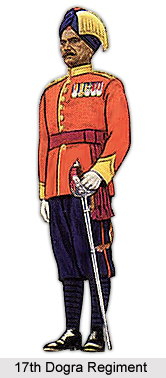 The 17th Dogra Regiment was one of the most prominent infantry units of the British Indian Army. The British Government of India re-grouped and re-established the regiments of the Indian Army, after the First World War. In 1922, a number large multi battalion infantry regiments were formed by the joining together the single battalion infantry units. These larger regiments comprised of 4 to 6 battalions.
The 17th Dogra Regiment was one of the most prominent infantry units of the British Indian Army. The British Government of India re-grouped and re-established the regiments of the Indian Army, after the First World War. In 1922, a number large multi battalion infantry regiments were formed by the joining together the single battalion infantry units. These larger regiments comprised of 4 to 6 battalions.
Formation of 17th Dogra Regiment
The 17th Dogra Regiment was formed in the year 1922 by the unification of 4 erstwhile British Indian Army regiments, which were originally part of the Presidency Armies in British India. These army units were the 2nd Battalion; 41st Dogras, the 1st Battalion, 41st Dogras; the 38th Dogras; and the 37th (Prince of Wales`s Own) Dogras. After the official reformation of the army, the 37th (Prince of Wales`s Own) Dogras was appointed as the 1st Battalion of the 17th Dogra Regiment; the 38th Dogras regiment became the 2nd Battalion; the 1st Battalion, 41st Dogras unit was developed as the 3rd Battalion 17th Dogra Regiment; and the 2nd Battalion, 41st Dogras were designated as the 10th (Training) Battalion.
Development of 17th Dogra Regiment
On 15th August 1947, the country gained freedom from the political dominance of the British Empire in India. This resulted in the occurrence of the Partition of India and consequently, the earlier British India was divided into the Union of India and the Dominion of Pakistan. Thus, the British Indian Army was divided among the India Army and the Pakistan Army. The 17th Dogra Regiment eventually became a part of the modern Indian Army and was re-designated as the Dogra Regiment. The unit includes the Dogras from the region of Himachal Pradesh, the hills of Punjab and Jammu and Kashmir.
Units of 17th Dogra Regiment
The present Dogra Regiment under the Army of independent India consists of several units, which are listed as follows-
* 2nd Battalion
* 3rd Battalion
* 4th Battalion
* 5th Battalion
* 6th Battalion
* 7th Battalion
* 8th Battalion
* 9th Battalion
* 10th Battalion
* 11th Battalion
* 12th Battalion
* 13th Battalion
* 14th Battalion
* 15th Battalion
* 16th Battalion
* 17th Battalion
* 18th Battalion
* 19th Battalion
Battle Honours of 17th Dogra Regiment
The 17th Dogra Regiment was awarded with several battle honours for their valuable and valiant military services. During the First World War the units received Battle Honours for La Bassee (1914), Givenchy (1914), Festubert (1914- 1915), Egypt (1915), Aden, Baghdad, NW Frontier India (1915- 1917), Mesopotamia (1915- 1918), Tigris (1916), Aubers, Neuve Chapelle, France and Flanders (1914- 1915), Kut al Amara (1917), Megiddo, Palestine, Nablu (1918), and Afghanistan (1919). The regiment also received Battle Honours during the Second World War, which includes Kota Bahru, Malaya (1941- 1942), Nunshigum, Donbaik, Magwe, Kennedy Peak, Burma (1942- 1945).
After the Indian independence and is re-designation as the Dogra Regiment, the unit was awarded with Battle Honours for Rajauri, Jhangar, Jammu and Kashmir (1947- 1948); Raja Picquet Chand Tekri, Hajipir, OP Hill, Jammu and Kashmir (1965); Dograi, Asal Uttar, Punjab (1965); Siramani, Chauddagram, Suadhi, East Pakistan (1971); Dera Baba Nanak, Punjab (1971). The regiment was also hounored with the Ashok Chakra, which is one of the Highest Gallantry Awards.



















